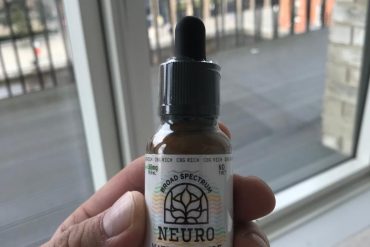Most CBD oil products are gotten from industrial hemp which has less CDB content in them than marijuana. CBD oil makers employ different methods to extract CBD from the hemp before adding it to the carrier oil. Different CBD oil has their different strengths and people apply them in various ways. But many users have come to believe that it is beneficial for pain relief.
According to a study, CDB doesn’t affect the endocannabinoid system in the body directly. What it does is to inhibit or activate other compounds in the endocannabinoid system (ECS). As an example, CBD stops the absorption of anandamide in the body.
This causes an increase in the level of anandamide in the bloodstream. Anandamide is the compound that is responsible for pain regulation in the body. An increased presence means the person would feel less pain. This is in fact, one of the reasons why CBD oil is known to be effective in relieving different types of pains in the body.
In a report published by the journal Cannabis and Cannabinoid Research, people started using cannabis to cure pain as far back as ancient China. By reducing inflammation in the nervous system and the brain, CBD oil might help to ease chronic pain. It is also believed that CBD oil promotes sound sleep and eases insomnia. People experiencing chronic pain can also sleep better as it is said to treat sleep disruption caused by the pain.
CBD oil does not have intoxicating effects unlike tetrahydrocannabinol (THC) which is the compound responsible for highness in cannabis users.
How CBD Oil Works Within the Body to Relieve Pain
CBD interacts with different proteins within the body system and the central nervous system. This includes interaction with the components of the endocannabinoid system (ECS) in the body. These endocannabinoid system components include receptors located in the central nervous system and the brain.
It also includes other cannabinoid receptors that are found in the immune system and the spleen. When THC interacts with these receptors, it binds strongly to them but CBD is an inverse agonist. So it has an opposite effect to that of THC on the receptors.
What CBD does in the body instead is to inhibit the absorption of anandamide in the body. Anandamide is a natural cannabinoid molecule responsible for regulating pain.
It is also associated with feelings of happiness and well-being. By inhibiting the absorption of these anandamide molecules, the level of anandamide in the bloodstream increases. This leads to a reduction in the feeling of pain throughout the body.
Previous researches have shown that alpha-3 glycine receptors are mostly targeted by CBD in the body. Glycine receptors are important for processing pain in the spine. Targeting them reduces inflammation and suppresses chronic pain associated that are caused by dysfunctional glycine receptors.
Vanilloid receptor TRPV1 is a receptor protein that is responsible for particular control functions like awareness of pain and inflammation in the body. CBD also activates receptor proteins like this in the body.
The expression and sensitivity of TRPV1 receptors increase in people with rheumatoid arthritis and in other cases where chronic pain is associated with a disease.
According to a study published in the British Journal of Pharmacology, CBD has analgesic properties which this receptor mediates. This made the researchers conclude that CBD could be a pharmacological alternative that is useful in the treatment of chronic pain that is associated with diseases.
Another study was published in the Neurotoxicology Journal, September 2015 edition. According to this study, CBD inhibits glutamate (which is responsible for increased sensation and transmission of pain in the body).
CBD reduces the level of glutamate in the brain and in the spinal cord. This consequently leads to a reduction in the pain that the person feels in their body.
There is no specified CBD dosage as directed by the FDA. This means that the CBD dosage is open to people’s personal interpretations. This in itself calls for caution. So anyone who wants to use CBD has to speak to their doctor first. Let the doctor advise you on if it’s a good idea for you or not. Ask the doctor for what dosage to take if they give you the go-ahead to use CBD.
Using CBD Oil for Pain
There are different methods of applying CBD into your body. The most commonly used methods are inhalation, ingestion, sublingual and transdermal application.
The optimal dosage for individual depends on factors like body weight, frequency of use, metabolism, and the quality of the CBD product. To find which treatment is most effective for you, you should start with a low but viable dosage.
You can increase the CBD dosage gradually until you are relieved of the pain. Once you know the method of application that works best for you, stick to it. Stick to the dosage that works best for you too, only tweak a little whenever it is necessary.
The best method for applying CBD oil if you’re using it for arthritis pain and muscle spasm is by transdermal patch or applying directly to the skin. According to the animal study on arthritis in 2016, researchers discovered that it is more effective to apply CBD through transdermal application than oral ingestion.
They discovered that the oral bioavailability of CBD is limited while the transdermal application has a therapeutic effect that lasts longer. This makes it better suited as a treatment for muscular pain or arthritis.
Research has also shown that CBD permeates ten times higher than THC when it is applied to the skin topically. You can apply CBD oil to your skin directly like cream or topical gel. To get the best out of CBD oil when you use it for treating pain and other health issues, it’s important for you to differentiate between high-quality CBD products in the market.
Sources of CBD
There are two sources of CBD products, cannabis-derived CBD product and hemp-derived CBD product. You can legally purchase CBD products that are derived from hemp throughout the United States. According to regulations enforced by the Food and Drug Administration (FDA), the amount of THC that hemp plants are allowed to have is 0.3%. Therefore, most of the CBD products that are derived from hemp either have a very little amount of THC or they don’t have any THC content in them at all.
CBD products derived from marijuana contains a higher level of THC in them and are only legal in states that legalize marijuana for adult use.
Side Effects of CBD Oil
Most people that use CBD oil have a good tolerance for it. But it is possible to still feel some side effects of using this product.
According to a review on cannabis and cannabinoid research, the most common side effects that users feel include:
• Diarrhea
• Tiredness
• Weight loss or weight gain
• Changes in appetite
When you use CBD oil alongside other medications, there is a possibility that the medication works more effectively or less effectively than it should.
This review also points out that some aspects of CBD are yet to be studied by scientists. One of such is the long term effect of CBD on the hormones. Further studies into this long term effect will help to determine if there are any side effects to using CBD in the body over a long period of time.
If you don’t already use CBD oil and you’re considering it. It is advisable that you discuss it with your doctor. This will help the doctor to monitor you in case of any changes and help you make the necessary adjustments.
Another reason you need to consult with your doctor before using CBD is that it may react with some over-the-counter medicines and dietary supplements and some other prescription medication.
It is also possible for CBD to interfere with a particular enzyme called cytochrome p450 complex. This interference can affect the ability of the liver to break down toxins. This increases the risk of toxicity in the liver.
A study also suggests that the anti-inflammatory effect of cannabinoids may reduce inflammation more than they should. This huge reduction in inflammation can diminish the defence system of the lungs and increase the risk of infection. So CBD and other cannabinoids may pose a risk of lungs problem for their users.
It is necessary to also consider that almost all the research carried out on CBD oil and its usefulness in pain reduction use adults during the trials. So it is not safe to use CBD oil on children.
Experts don’t recommend it. This is simply because there is little or no research on how CBD oil affects children or the effect of CBD on the development of a child’s brain. If you have to use CBD oil for a child, for seizures or any other illness, it’s important to firstly consult with your doctor. However, it is not recommended that you use CBD oil while you’re pregnant or while you’re breastfeeding a child.
There are a lot of applications of CBD and other promising possibilities. These uses include:
• Drug withdrawal and smoking cessation
• Treatment of seizures and epilepsy
• Treatment of anxiety
• Reducing the effects of Alzheimer’s
There are many studies that have suggested that CBD oil is very helpful in relieving pains in the body. However, more research has to be carried out using human subjects to determine the long term effects of using CBD.
There are a lot of potentials that CBD oil shows for pain relief. Some anecdotal evidence also suggests that CBD oil can also be used to manage chronic pain in people.
The absence of psychoactivity and a lack of intoxicating effect make CBD oil more promising for treatment. The fact that it has fewer side effects than many other medications that people take for pain increases the prospect.
If you don’t already use CBD oil and you wish to start using it, it is important for you to discuss it with your doctor first.
They can help you determine if it is good for you or not. They will also help you determine the dosage that you are to use.
- A new survey reveals – the pandemic has increased CBD use - March 30, 2021
- Epidemic of insomnia sees JustCBD formulate sleep-specific CBD gummies - March 18, 2021
- Learn How CBD Oil Can Cure Arthritis Pain - March 9, 2021







